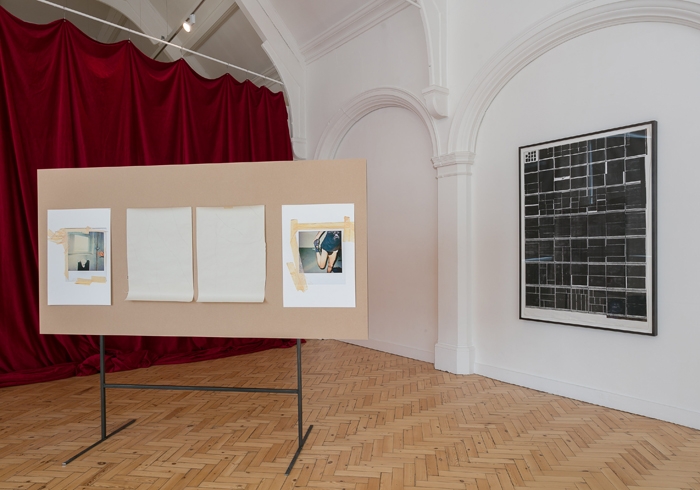How might we understand a life? Influence is hard to measure, if we even wanted to; and ‘legacy’ feels like such a corporate, profit-oriented word these days. But such a question hangs over Ian White’s posthumous exhibition Any frame is a thrown voice; the British writer, curator, teacher and artist passed away in 2013, with this exhibition focused on his layered, mischievous and often collaborative artistic output, showing documentation of several performances and restaging some of his multimedia installations. The impossibility of such an attempt to capture the originals is a perfect irony, given that White’s work in the ‘first’ place was deliberately fragmented and knowingly elusive, often including strategic quotations, personal asides and screenings of other people’s work.
The show wears this irony on its sleeve: as soon as we walk in, we’ve already been staged as performers in the work Democracy (2009–10/ 2018). On the wall, a slideshow of seemingly random photos flick by; four screens around the room show different versions of the performance by White that originally accompanied the slideshow, slowly (for example) bending and unbending his legs. Part of each instance of the work includes tuning in to the BBC World Service as a live soundtrack; when I walk in, several images of well-groomed gardens are given a voiceover by a Nigerian woman who has taken up archery to fight Boko Haram. We, in this case, are the unwitting performers of this reenactment, though we might not, as White does in every other case around us, end each performance with our trousers down around our ankles, shuffling awkwardly forward. Nearby, a vitrine is filled with a set of notebooks, their written content blocked out with black marker. As a hint, a typed anecdote alongside describes designer Karl Lagerfeld’s antipathy to archives: ‘I am supposed to do – I’m not supposed to remember!’
White’s writing and curatorial work helped to articulate the artist’s moving image work of the 1990s and 2000s; while I witnessed only a few of his performances before he passed away, this show highlights the playful prodding at textuality, theatricality and materiality that shaped his thinking. The Neon Gainsborough (2002–03/2018), originally an event performed at London’s Cubitt Gallery, undermines a slideshow of Thomas Gainsborough’s work with a video of hastily scrawled wry and vulnerable observations.
White’s collaborations with Jimmy Robert shape the majority of this exhibition, with Robert reworking their 2004 performance 6 things we couldn’t do, but can do now as a careful installation of drawings, photographs and writings. On one screen, Yvonne Rainer runs through her choreography Trio A (1978), while on another we see Robert and White do their own, stuttering version in front of a crowd in a Tate Britain foyer. On the wall, White’s notes describe some of the rehearsal process, focusing mainly on hiding, and not losing, his nicotine patch. White’s writing, dispersed around the show, is mostly delivered in short, shifting sentences that treat intimate anecdote on the same level as critical commentary, but have a meandering quality that succeeds in conveying the digressive nature of our own minds: nobody is ever fully focused, fully here. So being here, looking at photos and videos of these choreographed, annotated past moments, becomes more like standing between two mirrors, witnessing ghostly echoes of instances going off into infinity. White seems to have been aware of such a future state – that his structural re-placements, juxtapositions and regurgitations would build a haunted house. That hypothetical house, in any case, might be one such means of understanding influence, as cinema dissolves into a fractured future of handsets and streaming services and his ideas continue to feel relevant, providing a set of instructions and structures that others might continue to occupy and rearrange.
Ian White: Any frame is a thrown voice at Camden Arts Centre, London, 19 April – 24 June 2018
From the Summer 2018 issue of ArtReview
